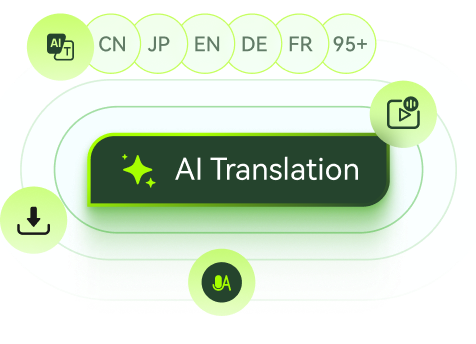Usually, subtitles automatically appear on the screen in certain parts of the video, mainly in a different language. These subtitles translate a certain language rather than the entire video for the user's understanding. Simply put, if a certain character is French and the rest of the movie is in English, these subtitles will display the French dialogue.
All these details can baffle the user's understanding; therefore, we have gathered essential details regarding these subtitles in this guide. To get English-forced SRT, navigate to this guide, where you'll learn everything in detail.
Part 1. What are Forced Subtitles?
When it comes to exploring English forced subtitle meaning, it's a type of text that is used to comprehend the non-native details of the video. Simply, these subtitles offer a clear understanding of the essential details that need to be translated or explained to the viewers. For instance, if a certain part of the video is in another language, forced captions will automatically translate and display them in the viewer's language.
Through this, they can easily understand and know what is being said. Generally, the main purpose of these subtitles is that the audience doesn't miss the crucial information, especially about a certain plot or character.
Part 2. What Are the Differences Between Forced Subtitles & Traditional Subtitles?
Moving on from understanding what forced captions are, we must understand the difference between forced and traditional subtitles. While both serve to enhance the viewing experience, their purposes and functionalities vary significantly:
| Aspect | Forced Subtitles | Traditional Subtitles |
|---|---|---|
| Definition | It displays subtitles for specific video parts, such as foreign dialogues. | These are the full subtitles that display dialogue and sounds for the entire video. |
| Purpose | Such subtitles provide context only where language changes, or dialogues need a translation. | It offers a complete video transcript of all spoken words and sounds. |
| Usage | They are used in multilingual movies where only parts of a foreign language are translated. | It is used for accessibility or convenience for viewers who need full dialogue. |
| Ability to Disable | ||
| Audio Dependency | Focuses on certain audio segments. | Focuses on the entire audio. |
Part 3. When to Use Forced Subtitles?
After learning the difference between forced and traditional subtitles, it is essential to know when forced subtitles are used. Here are a few situations when the subtitles appear on the screen and help the viewer understand the context:
-
Foreign Language Dialogue: Forced subtitles appear when a person speaks a foreign language during the video, which is hard for the international audience to understand. These subtitles are for better understanding and to keep the narrative flow of the video.
-
Non-Human or Fantasy Languages: In sci-fi or fantasy genres, characters often use fantasy language to communicate, like Elvish in The Lord of the Rings or Klingon in Star Trek. In this situation, forced subtitles enable viewers to grasp the meaning of the language while preserving the mystical tone.
-
Important Background Text: When written text, such as road signs, posters, or news headlines, is displayed, forced subtitles appear in the videos. The text provides translation and explanation behind it and helps blend narrative with visuals.
-
Inaudible and Muffled Dialogue: When the audio is intentionally or unintentionally inaudible like, during a whispering or loud crowd, a live movie translator provides forced subtitles to clarify the dialogue. These moments are crucial for the plot progression and suspense, and subtitles ensure viewers grasp the details without distraction.
Part 4. How to Create Forced Narrative Subtitles?
Apart from looking into the scenarios where we can use forced subtitles, let us dive into the guide to using BlipCut AI Subtitle Translator . This enhanced video editor tool allows users to get English-forced subtitles in SRT for videos. Using this tool gives access to over 70 languages to translate the subtitles generated. It also ensures you can edit the subtitle cards based on your preferences:
Features of BlipCut AI Subtitle Translator
-
Generate translated subtitles and add captions to video in over 70 languages.
-
Dub your voices into different languages with the help of integrated AI technology and reach a large pool of audiences.
-
Create short clips from long videos in a single click through the AI Clipping tool and focus on the key takeaways of the video.
-
Download subtitle file in SRT, VTT, TXT, PDF, or DOCX format.
-
Translate your videos in over 140 languages to better understand the content in a familiar language.
-
Clone your voice into over 50 different accents for an engaging video and audio.
-
Transcribe your audio into text with the ARS technology of BlipCut AI Video Translator .
Step-by-Step Guide on Creating Subtitles
Adhere to the steps below to better understand how this tool helps you get forced subs for videos.
-
Step 1. Access the Subtitle Generator Tool and Add the Link to Your Video
Initiate the process by accessing this tool and choosing the Subtitle Generator tool from the left bar. Then, upload or add a link to your video to move to the next step.

-
Step 2. Adjust the Languages to Generate Subtitles
Next, make sure the Source Language is set to auto-detect, and then, based on your preferences, choose your Translate To language. Now, click the Generate button and let the tool generate the forced subtitles.

-
Step 3. Edit the Subtitle Cards and Export the File
Moving on, as the subtitles are generated, you can edit them to match your preferences. Next, hit the Export tab in the bottom left corner to save the results on your device.

-
Step 4. Pick the Files You Want to Translate and Hit Download
Here, pick the options, including Video with Subtitles and Transcript , before tapping the Download button to save the video file to your device.

Part 5. How to Get Forced Subtitles for TV Shows?
If you don't have a live movie translator, you can access forced subtitles on the TV only if they are integrated into the TV show by cable operators. Once integrated, they will automatically appear on the screen where non-native text needs to be translated. You can easily comprehend the foreign language, signs, symbols, and plots to maintain your interest.
Furthermore, if you use any streaming service or digital TV, you might need to manually turn them on from the settings. Once activated, they will appear on the screen, making the non-native context comprehensive for you.
Conclusion
Summing up, forced subtitles are text that appears on the screen automatically when you have to understand the context of a foreign language. Therefore, in this article, we have mentioned all the necessary details to allow users to easily get forced subtitles. However, if you need to access all of your footage's subtitles, download BlipCut AI Video Translator and make this journey seamless.
Leave a Comment
Create your review for BlipCut articles













Blake Keeley
Editor-in-Chief at BlipCut with over three years of experience, focused on new trends and AI features to keep content fresh and engaging.
(Click to rate this post)